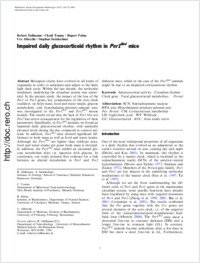Impaired daily glucocorticoid rhythm in Per1Brd mice
- Dallmann, Robert Institute of Zoology, School of Veterinary Medicine Hannover, Germany - Department of Neurobiology, University of Massachusetts Medical School, Worcester, USA
- Touma, Chadi Department of Behavioral Neuroendocrinology, Max Planck Institute of Psychiatry, Munich, Germany
- Palme, Rupert Institute of Biochemistry, Department of Natural Sciences, University of Veterinary Medicine, Vienna, Austria
- Albrecht, Urs Department of Medicine, Division of Biochemistry, University of Fribourg, Switzerland
- Steinlechner, Stephan Institute of Zoology, School of Veterinary Medicine Hannover, Germany
-
28.02.2006
Published in:
- Journal of Comparative Physiology A: Neuroethology, Sensory, Neural, and Behavioral Physiology. - 2006, vol. 192, no. 7, p. 769-775
English
Biological clocks have evolved in all kinds of organisms in order to anticipate and adjust to the daily light–dark cycle. Within the last decade, the molecular machinery underlying the circadian system was unraveled. In the present study, the impact of the loss of the Per1 or Per2 genes, key components of the core clock oscillator, on body mass, food and water intake, glucose metabolism, and hypothalamic-pituitary-adrenal axis, was investigated in the Per1 and Per2 mouse models. The results reveal that the lack of Per1 but not Per2 has severe consequences for the regulation of these parameters. Specifically, in Per1 animals, we found an impaired daily glucocorticoid rhythm, with markedly elevated levels during the day compared to control animals. In addition, Per1 mice showed significant differences in body mass as well as food and water intake. Although the Per1 are lighter than wildtype mice, food and water intake per gram body mass is elevated. In addition, the Per1 mice exhibit an increased glucose metabolism after i.p. injection with glucose. In conclusion, our study presents first evidence for a link between an altered metabolism in Per1 and Per2 deficient mice, which in the case of the Per1 animals might be due to an impaired corticosterone rhythm.
- Faculty
- Faculté des sciences et de médecine
- Department
- Département de Biologie
- Language
-
- English
- Classification
- Biological sciences
- License
- License undefined
- Identifiers
-
- RERO DOC 5957
- DOI 10.1007/s00359-006-0114-9
- Persistent URL
- https://folia.unifr.ch/unifr/documents/300118
Statistics
Document views: 124
File downloads:
- albrecht_idg.pdf: 255
